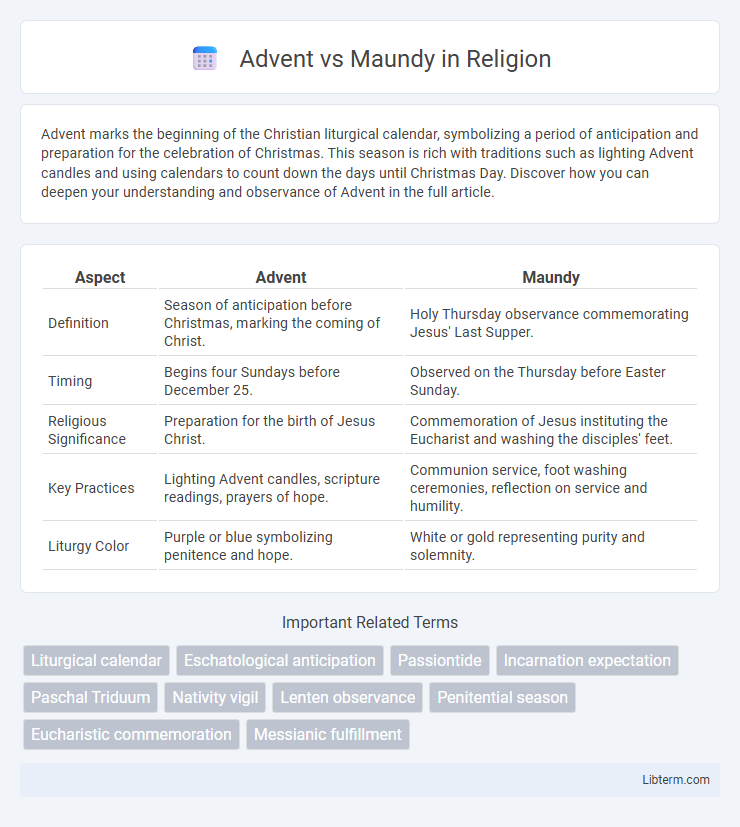Advent marks the beginning of the Christian liturgical calendar, symbolizing a period of anticipation and preparation for the celebration of Christmas. This season is rich with traditions such as lighting Advent candles and using calendars to count down the days until Christmas Day. Discover how you can deepen your understanding and observance of Advent in the full article.
Table of Comparison
| Aspect | Advent | Maundy |
|---|---|---|
| Definition | Season of anticipation before Christmas, marking the coming of Christ. | Holy Thursday observance commemorating Jesus' Last Supper. |
| Timing | Begins four Sundays before December 25. | Observed on the Thursday before Easter Sunday. |
| Religious Significance | Preparation for the birth of Jesus Christ. | Commemoration of Jesus instituting the Eucharist and washing the disciples' feet. |
| Key Practices | Lighting Advent candles, scripture readings, prayers of hope. | Communion service, foot washing ceremonies, reflection on service and humility. |
| Liturgy Color | Purple or blue symbolizing penitence and hope. | White or gold representing purity and solemnity. |
Understanding Advent and Maundy: Key Differences
Advent marks the beginning of the Christian liturgical calendar, spanning four weeks dedicated to anticipation and preparation for the birth of Jesus Christ, symbolized by the lighting of candles on the Advent wreath. Maundy, observed during Holy Week, commemorates Jesus' Last Supper, emphasizing service and humility through rituals like foot washing and the distribution of Maundy money. The key difference lies in Advent's focus on hopeful expectation before Christmas versus Maundy's reflection on sacrifice and servant leadership preceding Easter.
Historical Origins of Advent and Maundy
Advent originates from the Latin word "adventus," meaning "coming," and was established in the early Christian church as a preparatory season for Christmas, marking the arrival of Christ. Maundy, derived from the Latin word "mandatum" meaning "commandment," traces back to Jesus' commandment at the Last Supper to love one another, symbolized by the washing of the disciples' feet on Maundy Thursday. Both traditions hold deep historical roots within Christian liturgical practices, representing anticipation in Advent and servant leadership in Maundy.
Theological Significance of Advent
Advent marks the liturgical season of anticipation and preparation for the celebration of Christ's birth, emphasizing themes of hope, repentance, and the fulfillment of Old Testament prophecies. Theologically, Advent underscores the dual nature of Christ's coming, both as the historical incarnation and the promised second coming, inviting believers to spiritual readiness. This period contrasts Maundy Thursday, which centers on the institution of the Eucharist and Jesus' mandate of servanthood during the Passion narrative.
The Meaning Behind Maundy Thursday
Maundy Thursday commemorates the Last Supper of Jesus Christ with His disciples, highlighting themes of humility and service through the act of washing feet. It symbolizes Jesus' commandment to love one another, reflecting the word "maundy," derived from the Latin "mandatum," meaning commandment. This day plays a pivotal role in Holy Week, bridging the anticipation of Easter and the solemn remembrance of Christ's passion.
Liturgical Practices: Advent vs Maundy
Advent liturgical practices emphasize anticipation and preparation for Christ's birth, featuring readings from Isaiah, Psalms, and the Gospel highlighting hope and prophecy, with the lighting of the Advent wreath marking each of the four Sundays. Maundy Thursday rituals center on Jesus' Last Supper, including the washing of feet, Holy Communion, and readings from the Gospel of John that reflect themes of service, sacrifice, and covenant. The contrasting liturgies showcase Advent's forward-looking expectancy compared to Maundy Thursday's intimate remembrance of Jesus' commandment to love and serve.
Symbols and Traditions of Advent
Advent is symbolized by the Advent wreath, consisting of four candles representing hope, peace, joy, and love, which are lit progressively each Sunday leading up to Christmas. Traditional practices include the use of Advent calendars to count down the days and special devotional readings emphasizing anticipation of Christ's birth. These symbols and customs create a reflective atmosphere contrasting the communal foot-washing and Eucharistic focus of Maundy Thursday in Holy Week.
Rituals Associated with Maundy Thursday
Maundy Thursday rituals center on the commemoration of Jesus Christ's Last Supper, including the washing of feet, symbolizing humility and service, and the distribution of Maundy money to the poor, reflecting charity and remembrance. The Eucharist is central, with churches performing special Holy Communion services to honor the institution of the sacrament. These rituals emphasize themes of sacrifice, love, and community unity in Christian liturgical traditions.
Advent and Maundy in Christian Calendars
Advent marks the beginning of the Christian liturgical year, observed over four Sundays leading up to Christmas, emphasizing anticipation and preparation for the birth of Jesus Christ. Maundy, celebrated during Holy Week on the Thursday before Easter, commemorates Jesus' Last Supper and his commandment to love and serve one another, symbolized by the washing of feet. Both seasons hold distinct theological significance within Christian calendars, highlighting themes of expectancy during Advent and humility and service during Maundy Thursday.
Reflections: Spiritual Preparation in Advent and Maundy
Advent invites believers to engage in spiritual preparation through reflection on hope, anticipation, and the coming of Christ, emphasizing readiness for both His birth and Second Coming. Maundy Thursday calls for contemplative reflection on service, humility, and the new commandment given by Jesus at the Last Supper, fostering a deep spiritual awareness of sacrificial love. Both seasons uniquely encourage believers to deepen their faith by contemplating key aspects of Christ's mission and their personal spiritual journey.
Lessons and Legacy: Advent and Maundy for Modern Christians
Advent emphasizes anticipation and preparation for the coming of Christ, encouraging modern Christians to embrace hope, reflection, and spiritual readiness through scripture readings and prayerful meditation. Maundy Thursday highlights Jesus' example of humility and service, inspiring believers to practice selflessness and community support by recalling the Last Supper and Jesus' commandment to love one another. Together, these observances weave a legacy of faith, humility, and active discipleship that shapes contemporary Christian worship and ethical living.
Advent Infographic

 libterm.com
libterm.com